Understanding Permethrin

What Is Permethrin?
Widely trusted by pest control professionals and homeowners alike, permethrin is effective against fleas, ticks, ants, mosquitoes, cockroaches, mites, lice, and more. It works by targeting the nervous system of insects, paralyzing and killing them quickly upon contact or ingestion. Depending on the formulation, permethrin can be applied as a spray, dust, concentrate, fogger, or cream, making it a versatile solution for both preventative and active pest management.
When used according to label directions, permethrin is highly effective and low in toxicity for humans and pets, making it suitable for use inside the home, in gardens, on animals, and even in medical applications like lice and scabies treatments. Its proven reliability, fast action, and lasting residual effect make it one of the most widely used and respected insecticides worldwide.
Targeted Pests
| Product Type | Targeted Pests |
|---|---|
| Residual Sprays (Indoor & Outdoor) | Cockroaches, ants, spiders, silverfish, fleas, ticks, flies, mosquitoes |
| Insecticidal Dusts | Bed bugs, ants in wall voids, silverfish, cockroaches, bird mites, carpet beetles |
| Smoke Generators / Foggers | Fleas, cockroaches, moths, silverfish, spiders (in enclosed spaces) |
| Concentrated Liquids | Lawn grubs, armyworms, caterpillars, mosquitoes, ants, mites, flies |
| Aerosol Sprays (Crack & Crevice) | Cockroaches, silverfish, ants, spiders, fleas (in corners and skirting boards) |
| Lotions & Creams (Medical Use) | Lice, scabies mites (human treatment – medical-grade only) |
| Pour-On Animal Treatments | Flies, lice, mites, ticks (on livestock or horses under vet guidance) |
| Permethrin-Treated Clothing & Gear | Ticks, mosquitoes, biting flies (repellent use for outdoor protection) |



Different Types
What Are the Implications of Using Permethrin and Other Synthetic Pyrethroids?
-
Cautions and Considerations
1. Toxic to Aquatic Life
Permethrin is highly toxic to fish and aquatic invertebrates. Care must be taken not to apply near ponds, waterways, or drains. Even small runoff amounts can harm aquatic ecosystems.
2. Overuse Can Lead to Resistance
Repeated or improper use may contribute to insect resistance, reducing effectiveness over time — especially in pests like head lice, bed bugs, and agricultural insects.
3. Potential Irritation
While generally safe, permethrin can cause skin or eye irritation in sensitive individuals, and must not be inhaled in large quantities. Proper protective gear should be worn during application.
4. Not Safe for All Pets
While safe for dogs in vet-approved products, permethrin is toxic to cats, even in small doses. Always check product labels for pet safety warnings and usage instructions.
Positive Implications
1. Effective, Broad-Spectrum Control
Permethrin provides quick knockdown and long-lasting residual protection against a wide range of insects including ants, cockroaches, fleas, mites, ticks, and mosquitoes.
2. Versatility Across Applications
From indoor sprays and garden dusts to clothing treatments and medical lice creams, permethrin can be formulated for safe use in many environments when applied correctly.
3. Low Mammalian Toxicity (When Used Properly)
Compared to older pesticides, synthetic pyrethroids like permethrin are designed to be safer for humans and pets — with low absorption through the skin and rapid breakdown in the body.
4. Environmental Stability
These compounds are more stable in sunlight and rain than natural pyrethrins, making them suitable for outdoor use and long-term barrier protection.
Recommended Products
Shop our best Permethrin Products for Inside and outside.









 Mosquito Traps
Mosquito Traps